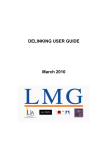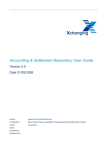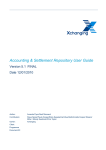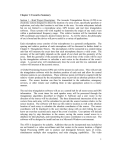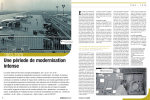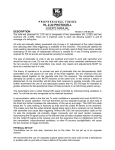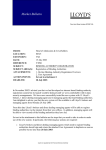Download DELINKING USER GUIDE MAY 2006
Transcript
DELINKING USER GUIDE MAY 2006 Page 1 of 15 Table of Contents 1 Introduction P3 2 Advice of signed lines for Contract Certainty P3 3 Scope of delinking P3 4 Delinking Process P3 5 Broker delinking screens P4 6 Insurer Delinking Screens P9 7 Special Processing P11 8 Broker set up and testing P13 9 Signing Messages P14 10 Further Information P14 11 Appendix A - Delinking Stamp P15 Page 2 of 15 DELINKING PROCEDURES MAY 2006 1 Introduction Delinking was introduced in October 1999 as one of the International Process Compliance (IPC) initiatives. Delinking separates the submission of closing information to the bureau from the instruction to settle. When the LMP market reform programme initiated in 2000 it championed delinking as a means of speeding up premium payment and the issuance of evidence of cover to the client. The LMP Report issued in November 2000 recommended that “Delinking of premium advice from broker instruction to settle will be adopted for all direct, facultative, and excess of loss closings for both original and additional closings. Delinking has been further endorsed by the market reform programme for its contribution towards achieving contract certainty. This document sets out the broker and (re)insurer procedures for using delinking. It should be read in conjunction with the other delinking documentation, available for download from the market reform website www.marketreform.co.uk. 2 Advice of signed lines for Contract Certainty Principle 4 of the Contract Certainty Code of Practice states “Brokers will calculate signed lines by inception and notify them to each insurer no later than 30 days after inception date, or by inception date on request.” The best way of achieving this is to use delinking. Delinked accounts should be submitted to Xchanging within 30 days of inception to meet the contract certainty requirements. 3 Scope of delinking 3.1 In-Scope Currently all Direct, Facultative and Excess of Loss closings whether Original Premiums, Additional Premiums and Return Premiums may be delinked unless specifically stated as out of scope below. 3.2 Out-Scope The following transaction types are outside the scope of delinking: • Proportional treaty statements. • FDO Original signings. • Reinstatements linked to claims. • Nil Adjustments. • London Market business settled outside the bureau, e.g. Lloyd’s Motor. • Lloyd's only – Premium Reserve Accounts and Paid by Cheque items. 4 Delinking Process 4.1 Broker Submission The broker places the risk, signs down the market and prepares the London Premium Advice Note(s) (LPAN(s)) and other closing documentation. The documents required for delinked submissions to Xchanging Ins-sure Services (hereafter known as Xchanging) are the same as for non-delinked items. The documentation is then submitted to Xchanging as soon as possible. Xchanging recommend that delinked closings are submitted at least six working days prior to the Settlement Due Date (SDD). This will allow Xchanging to process the closings and return them to the broker in time for the items to be released for settlement on or before the SDD. If items are submitted nearer to the SDD they will still be processed as delinked but run the risk of being signed late. For convertible currency items the broker is required to enter a nominal rate of exchange on the LPAN's. This can be updated by the broker at settlement when the actual exchange rate is known. Page 3 of 15 DELINKING PROCEDURES MAY 2006 Each transaction must be clearly marked as "IPC Delinked". This must be shown on the LPAN and on the coversheet, if used, to avoid confusion with other submissions. If the documentation is not clearly marked as "IPC Delinked" the transaction will be treated as a cash signing and will be included in the next settlement run. An example "IPC Delinked" stamp can be found in Appendix A of this document. 4.2 Xchanging Processing Xchanging will check and process the closing and flag the item as delinked. Any technical accounting queries may be resolved at this stage, thus ensuring that they do not delay subsequent premium payment. Xchanging will process the delinked transaction but withhold the item from settlement. The transaction will still be given a signing number and date, which will be shown on the slip and endorsements returned to the broker. In addition the slip/endorsement will be marked as ‘delinked’. Details of the premium due at settlement are added to a suspense file known as the Interactive Settlement System (ISS). There is a common application for all Lloyd's and IUA delinked accounts. 4.3 Release for Settlement Once the client pays the premium the broker releases the item for settlement. Lloyd's and company market insurer items are stored together on a single ‘suspense’ database, the ISS. Brokers have two methods of releasing items for settlement, either via the interactive trigger or by using the RESETT message to automate the process. At the end of each day all items that have been released for settlement are removed from the suspense file and processed through central accounting in the usual manner. Delinked transactions released by the broker up to the end (6pm) of the settlement due date will be regarded as on-time. For convertible currency transactions the broker will be able to update the rate of exchange when the item is released. The system will check the broker’s exchange rate against the rate held by Xchanging which is updated each Monday. A 10% tolerance against the current exchange rate held by Xchanging will be accepted. If the broker wishes to enter an exchange rate outside of that tolerance it will be necessary to contact Xchanging to execute the release (see Section 7.6). 4.3.1 Interactive trigger An interactive function, called IPC RELEASE FOR SETTLEMENT, is provided on the Xchanging system, that enables brokers to release both company market and Lloyd's delinked entries for settlement. This function can be found as an option on the BUREAU GENERAL FACILITIES menu. Refer to Section Five of this document for details of the screens. 4.3.2 RESETT Message As an alternative to the interactive trigger, brokers can use the RESETT message. RESETT is the globally recognised ACORD standard EDI message for financial account data and allows brokers to automate the release of items for settlement. Copies of the RESETT specification can be obtained from the LMBC. 5 Broker Delinking Trigger Screens When the release for settlement function is selected the user will enter the selection and sort criteria. A list of items matching the selection criteria entered will be presented, in the specified sequence. When all selections have been made, each item will be presented in turn. For each item additional screens will be displayed showing further details of the transaction. If the user has update authority it will be possible to update some data such as the exchange rate and to release the item for settlement. An effective date can be applied to the release. A final screen is optionally available, to show the amounts and due dates of any deferred instalments. Page 4 of 15 DELINKING PROCEDURES MAY 2006 5.1 5.1.1 Screen 1 – Release for Settlement Filter options This screen allows brokers to specify selection criteria for the transactions they wish to view and sort options to determine the order in which they are to be presented. • Broker number must be entered. This will be pre-set for you by the system, but can be changed if your organisation operates more than one broker number. • You must indicate for which market(s) you want to see transactions. Enter a ‘Y’ next to any or all of the bureau identifiers shown (ILU, LIRMA, Lloyd’s). • An optional settlement currency code can be entered to limit the search. If nothing is entered all currencies will be included. • Broker contact can be entered to limit the search to those entries where that name was given on the LPAN. This is optional. • Released signings. If ‘N’ is entered then only transactions not yet marked for release will be selected. If ‘Y’ is entered then only items already marked for release, but still on the suspense file, will be selected. If nothing is entered then all transactions will be selected. 5.1.2 Sort options Enter ‘Y’ in one of the options to determine the order in which you want the selected transactions to be listed. The sequence options are Settlement Due Date, Broker Reference 1, Broker Reference 2, or Unique Market Reference. Page 5 of 15 DELINKING PROCEDURES MAY 2006 5.2 Screen 2 – List items pending This screen lists the items selected by the broker. The screen is scrollable left/right and up/down, using PF keys as shown. Any number of items may be selected from this screen at one time. To do this enter an ‘S’ into the ‘select field’ on the left side of the screen next to the item. To de-select an item that was chosen in error, enter a space into the select field. Not all items may have a select field appearing next to them. Where items have been grouped by Xchanging (e.g. where the premium for one slip must be paid at the same time) only the first item in the group will be able to be selected. Selection of that item will cause all of the other items in the group to be automatically selected by the system at the same time. When all selections have been made, press PF5 to display further details of the transactions selected. Page 6 of 15 DELINKING PROCEDURES MAY 2006 5.3 Screen 3 – Transaction Details This screen displays the detail of a selected transaction. If a number of transactions have been selected – either by the user or by the system for grouped items – each transaction will be presented in turn. For users who only have enquiry authority all data will be protected. For users with update authority the following fields can be amended: • Broker contact name and telephone number • Broker reference 1 and 2 • Rate of exchange (for convertible currency items only) • Net premium for settlement (for convertible currency items only) • The release indicator • The effective date for the release To release an item for settlement, enter ‘Y’ in the release field. Optionally an effective date can also be entered. Items marked for release will remain on the suspense database until the end of the current day, or the end of the effective date if entered. Up to that time it is possible to de-activate any items marked for release by entering ‘N’ in the release field. In some circumstances the system may prevent the release of an item – e.g. if a premium warranty is in effect and the warranty date has expired. An error message will be displayed to explain the reason for not allowing the release. In these cases it will be necessary to contact Xchanging to execute the release (see Section 7.6). Page 7 of 15 DELINKING PROCEDURES MAY 2006 5.4 Screen 4 – Instalment Details This screen lists any deferred instalments for the transaction. The screen, which is selected by pressing PF5, will only be displayed if deferred instalments are present. If the rate of exchange has been updated for a convertible currency transaction, Xchanging will automatically re-calculate the net instalment amounts. The broker cannot update this screen. Page 8 of 15 DELINKING PROCEDURES MAY 2006 6 Insurer Delinking Screens 6.1 Company Insurer Enquiry function Delinked items do not appear on the LPC signings history enquiry system until they have been released into settlement. A separate enquiry function is provided for companies, allowing them to view delinked signings for which they are on-risk and that are resident on the suspense database awaiting settlement. The IPC DELINK COMPANY ENQUIRY can be found as an option on the GENERAL ENQUIRIES menu. The following screens will be displayed: Screen 1 – IPC Delinked entries awaiting settlement This screen allows companies to enter selection criteria and sort option for the enquiry. The sort options allow the results to be displayed according to Settlement Due Date or Signing Date (ie. the date the items were added onto the suspense database). Page 9 of 15 DELINKING PROCEDURES MAY 2006 Screen 2 – List of items pending This screen displays all the items selected by the company. The screen is scrollable left/right and up/down using PF keys. To select an item from the list, enter an “S” in the field next to the record on the list screen and press <ENTER>. Screen 3 - Transaction Details This screen displays the detail of the selected transaction. Page 10 of 15 DELINKING PROCEDURES MAY 2006 Screen 4 – Instalment Details This screen lists any deferred instalments for the transaction. The screen, which is selected by pressing PF5, will only be displayed if deferred instalments are present. 6.2 Lloyd's Facilities Lloyd's underwriters may check if an item has been delinked in three ways. Firstly there is the Account Enquiry application that is available. Secondly if syndicates "opt in" they will be advised of delinked transactions in the Underwriter Signing Message (USM). The third option is a comma delimited file (CSV). 7 Special Processing 7.1 Early Policies At the initial submission of the closing advice (LPAN), Xchanging is able to sign broker produced policies, or create policies where they are within the scope of the Policy Production Service (PPS) for all non-marine and aviation business. For all marine business and Political Risks placed in Lloyd’s however, Xchanging have an instruction from the respective insurer trade associations, that such policies must not be signed Stage Two prior to premium payment. The broker can still, should they wish to do so, submit the policy to Xchanging for checking at the initial delinking stage. However these will have to be resubmitted for sealing once the premium has been paid (this applies to Slip policies as well as full policies). This instruction will not apply to individual risks where brokers and insurers have agreed on a case by case basis that policies may be signed prior to premium payment. Where this applies the BUREAU ARRANGEMENTS heading in the Subscription Agreement section should specify “Insurers hereby agree that the policy may be signed as stage two by Xchanging prior to premium payment by the (re)insured”. Page 11 of 15 DELINKING PROCEDURES MAY 2006 7.2 Grouped Items Some transactions are grouped by Xchanging to indicate that they should normally be released for settlement simultaneously, e.g. multi-currency contracts. When these appear on the list screen, only the first of the group will be able to be selected. If it is selected, the dependent items will also be presented for action and the system will ensure that all of them are released together. There may be cases where the broker and underwriters decide that it would be inappropriate to group these transactions. In these instances the slip will need to make it clear that this is how the premium will be processed. It is recommended that the following words are shown under the BUREAU ARRANGEMENTS heading of the Market Reform Slip: “Underwriters agree that the broker may release de-linked premiums for this contract into settlement at different times” The broker should also clearly mark all LPAN’s with the words “DO NOT GROUP”. Further information can be found in Xchanging market circular 2006/007, entitled “IPC Delinking and grouping” issued on 19th January. 7.3 Premium Payment Warranties Transactions which are subject to a premium warranty will be flagged by Xchanging when data is captured from the initial submission. Brokers will be able to release these items for settlement up to the end of the warranty date, as normal. However, once the warranty date has expired it will be necessary to re-submit the item to Xchanging for release. Evidence of the underwriter’s agreement to the extension of the premium warranty will be required. 7.4 Late signings & Credit Control There may be circumstances where the client has not paid the premium and the SDD has already passed. There is still value in delinking these transactions since it gives underwriters better signed line and premium related data to assist with their credit control process. 7.5 Declaration Processing Declarations settled on a paid bordereau basis, or as Additional Premium’s off an FDO may be processed as delinked as long they are all to be settled at the same time. 7.6 Release by Xchanging As an alternative to using the interactive system or the RESETT message, brokers can contact Xchanging to execute the release into settlement. This may be because: • the broker does not have access to the interactive system, • the premium warranty date has been breached, • the rate of exchange is outside the tolerance allowed. In these instances, the broker should initially phone the appropriate section head at Xchanging to make them aware that they would like an item to be released for settlement. Confirmation of this request and details of the signing number for the premium entry involved should then be e-mailed (or faxed) to the section head. Details of such requests should be submitted to Xchanging before 1pm on the day when release is required. Where a premium warranty date has been breached, Xchanging will require evidence of the Underwriter's agreement to the breach of the premium warranty. Contact details can be found in Section Ten of this document. 7.7 Contract changes Any change to a delinked account prior to settlement must be corrected by endorsement. This will ensure that underwriters are aware of the change and will receive the appropriate revised details via the delinked signings message. Where Page 12 of 15 DELINKING PROCEDURES MAY 2006 past experience has shown that such changes are probable it may be that these contracts are not suitable for delinking because of the extra work this will create. 7.8 Cancellations Cancellation of a delinked signing will cause a cancelling entry to be signed and advised to (re)insurers. Both the cancellation and the signing being cancelled will then be removed from the suspense database. Neither of the entries will be processed into settlement. 7.9 Extending the terms of trade There may be occasions where a premium has not been paid and the broker requests that the leading underwriter extends the SDD so that the item is not signed late. If this occurs proof of the underwriters agreement to the extension should be faxed or emailed to Xchanging by no later than 1pm on the day that the extension is required and they will update the SDD accordingly. It is recommended that brokers should also make contact by telephone, to ensure someone is aware the fax/email is coming through and that it needs attention. It is not critical that the update to the SDD be done before the item is released. As long as it is done within the same calendar month, then the broker's performance as measured by the Late Signing Report will not be adversely affected. Contact details can be found in Section Ten of this document. 8 8.1 Broker set up and testing Set up Prior to making use of the delinking process brokers will need to set themselves up to use the Xchanging interactive trigger. The "IPC RELEASE FOR SETTLEMENT" function, can be found as an option on the BUREAU GENERAL FACILITIES menu. Access to the function is controlled by Xchanging standard on-line security system. Two levels of access are available: • IPC ITEMS AWAITING SETTLEMENT. This is the enquiry function, which must be given to all users who need access for enquiry or for update/release. • IPC UPDATE/RELEASE. This function must additionally be given to any users who need to be able to update and release transactions. Brokers need to contact their security administrators to add the function to their user profile. 8.2 Testing Xchanging will assist brokers with testing the delinking process if brokers wish to test their delinking procedures prior to using the process for real business. LPAN’s for the test cases must be clearly marked ‘IPC DELINKED’ and ‘TEST TRANSACTION’ and should be sent to: Company Transactions Lesley Hughes Insurance Services Department Xchanging Ins-sure Services Folkestone Lloyd's Transactions Enquire Helpdesk Xchanging Ins-sure Services Chatham A contact name, and either a fax number or an email address must also be provided. Lesley and the Enquire Helpdesk will be the central points of contact for Xchanging during the testing. Test LPAN's will not be subject to the normal Xchanging technical checks. They will be entered as presented, with dummy values being added by Xchanging in respect of any missing data. At the end of each day, completed test cases will be given dummy signing numbers. A fax or email will be returned to the broker contact to inform them of the signing numbers. Signings will appear on the suspense database the next day, on the LPCTRIAL system, where they will be available to brokers by means of the IPC RELEASE FOR SETTLEMENT function. Page 13 of 15 DELINKING PROCEDURES MAY 2006 Items that are released by brokers will be removed from the suspense database at the end of the day - or at the end of the effective date, if entered. There will be no further processing. Brokers interested in implementing the RESETT message should contact the Xchanging Folkestone Service Desk on 01303 854444. 9 Signing Messages 9.1 Company market business For the companies, delinked signings are not included in the ILUCSM and the LIRMA DSIGN messages until they are released for settlement. Companies have the option of receiving an additional early delinked signing message that is sent when the delinked signing is added to the suspense file. There are separate messages for ILU and LIRMA, (IPCCSM and IPCDSM) which follow the same format of ILUCSM or DSIGN. There is also an option for companies to take a limited amount of information for delinked signings, as a comma-delimited file. This is the same format for ILU and LIRMA. 9.2 Lloyd's Syndicates can chose whether they receive details of delinked transactions in the form of an additional USM prior to premium payment. 9.2.1 Opted In If a syndicate “opts in” they will be sent the first USM when the initial delinked item has been processed by Xchanging, prior to premium payment. The USM includes a signing number and date, SDD, and a premium value but no ‘real’ Actual Payment Date (it will be expressed as APD‘99999999’). It is important to note that the allocation of a signing number and date at this stage DOES NOT denote any monies will be settled. The Business Category will either be PRD (delinked premium) or DPD (delinked deferred premium). When the broker releases the premium for settlement the syndicate will receive USM versions 2 & 3 (assuming no corrections), indicating the payment will be made. The Actual Payment Date will be amended to the date the item was settled and the Business Category will also be updated to either PRM (premium) or DPM (deferred premium). 9.2.2 Opted Out If a syndicate "opts out" then they will only be advised of delinked transactions in the USM when they have been settled. The Actual Payment Date will contain the settlement date and Business Category will be either PRM (premium) or DPM (deferred premium). 9.3 Brokers From Q3 2006, brokers will have a choice of which message they may receive when an item is delinked. Brokers may choose the EDI IPCBSM message or alternatively received a CSV file. When the item is settled the broker will receive the standard Broker Signing Message (BSM). Further details can be found in the A&S Repository functional specification. 10 Further information Class of Business X/L Fac R/I Binders Binders Direct Direct – Non Marine Direct – Marine Direct - Aviation Bureau Lloyd’s & Companies Lloyd’s & Companies Lloyd’s Companies Companies Lloyd’s E-mail [email protected] [email protected] [email protected] [email protected] [email protected] [email protected] Lloyd’s Lloyd’s [email protected] [email protected] Page 14 of 15 APPENDIX A - DELINKING STAMP Page 15 of 15















